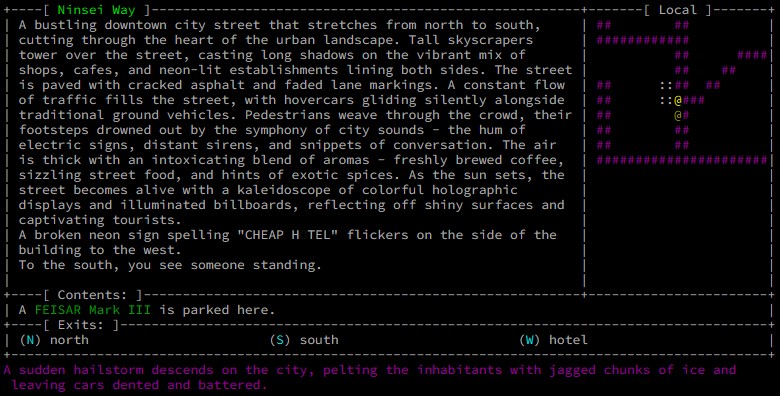First time playing a MOO? Think of it as the precursor to modern MMO titles, from a time where the only option to play “massively multiplayer” games was in the form of a text-based game. Bandwidth capabilities and graphics renderers just weren’t up to the task of handling more than the most basic of single-player games, or required specialized gaming consoles to play what’s now called “couch co-op”.
We’ve made it as easy as possible to get going with Neural Net so you can jump in and start exploring; read the Connecting doc to see how you can play – a couple clicks and typed commands and you’ll be ready for your first character! Read on for more details once you’re in the game…
Basics
It can be daunting starting a new game, taking the time to get used to the controls, UI, and mechanics. This doc will hopefully help you get on your feet and moving in the world of Neural Net in no time!
Key Commands
help <topic> — for example, ‘help intro’ will give a great overview of the commands and how to use them if you are not used to playing MOO’s. typing ‘help’ by itself will show you a summary of the various topics.
help game-index — shows a list of help topics that are directly related to surviving and thriving in NeoTokyo
look <me/here/something> — looking at things is how you get information about the world around you, including things like how your weapon, fellow players, or vehicles look.
examine <anything> — examining things is how you find out what commands (and how they need to be typed) are available to you with various objects.
say <anything> — the simplest way to interact with others, this is how you say something to everyone in the same area (room) as you
Area/Room Explanation
The first time you see the descriptions for the area you are in, it can be a little overwhelming. Don’t fret, we can help!

At the top, it says your current room’s name in bright green, in this case “Ninsei Way” is the street my character is at. Further to the right on the same line, the “Local” header is for the local map below it, which you can get more info on from the ‘help map‘ command.
The large block of text on the left includes a few important things:
- the description of the area you’re in, which can give you details and clues about where you are.
- any detail messages follow the description, in this case we can see there’s a callout for the hotel to the west.
- proximity details; in this case, we have someone directly to our south.
The “Contents” section appears if there are other objects in the area, for example any vehicles, people, or interactive items. We can see there is a vehicle parked here. See ‘help interaction‘ for more info on interacting with these objects.
The “Exits” section tells you which directions you can go, and in some cases it gives direct hints as to where that exit leads (e.g. the hotel). Exits are typically in one of the eight cardinal directions (north, west, south, east, northwest, northeast, southwest, southeast) or up/down, in/out. You can move through exits by either typing the short or long name of an exit, e.g. ‘n‘ is the same as typing ‘north‘ for the exit shown as “(N) north”. If you know where you are going, you can stack movement commands by typing ‘go <direction> <direction> <etc>‘ – see ‘help movement‘ for more info!
Last but not least, in magenta is the local weather description for your area. You will only see these messages when outside, and they may or may not have various effects on the game world!